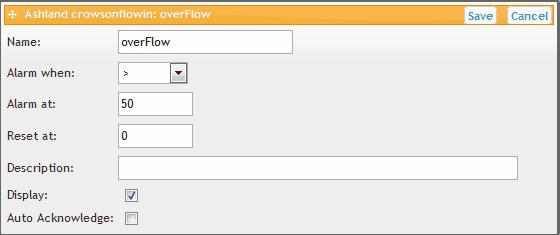|
Editing Alarms |
Top Previous Next |
|
To create a new alarm, click on the + to the right side of the alarm panel. This will display a list of tags similar to the list in the Basics menu:
To add an alarm to a particular tag, click on the + next to the desired tag. You can add as many alarms as you need for any tag. This brings up the alarm edit window. You can get to this window for an existing alarm by clicking the pencil icon next to the alarm listed in the alarm panel.
Name: the short name for the alarm. It is used in the alarm display controls, so it should be somewhat descriptive, however not long as the columns in the alarm display controls are not very wide. Alarm when: select a desired operator that is used with your tag value and the Alarm at condition. So, in the screenshot above, the alarm would occur when the tag crowsonflowin is greater than 50. The alarm would reset when the tag goes below, or is equal to 0. Alarm at: the value that the tag value is compared to that determines when the alarm fires. Once the alarm fires, it will not fire again until the reset condition has been achieved. Reset at: the value that the tag value is compared to that determines when the alarm resets. This only applies when the alarm is in the fired state. Description: a long description of the alarm. Put whatever you need here. Display: if checked, then the alarm appears in the alarm status and history controls. If not checked, it does not, but the alarm still will send notifications. Auto Acknowledge: if checked, then an alarm that has reset is automatically acknowledged. If not checked, then you have to manually acknowledge alarms. Until an alarm is acknowledged, it will remain towards the top and highlighted in the alarm status control. Data Age Greater Than There is one special Alarm type called "Data age when greater than" that you can select for the Alarm when property. If this is selected then the alarm will fire when the server doesn't receive any new data for that data point in the specified number of seconds. This is a useful alarm to ensure that your remote data source connections are still active. One important point: this is only evaluated every 30 seconds so your Alarm at and Reset at values must be greater than or equal to 30. |

